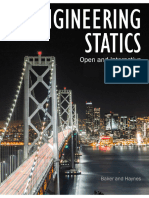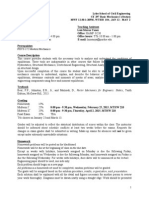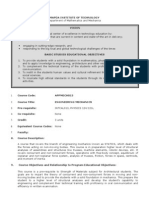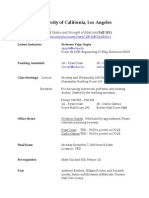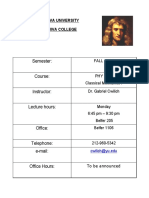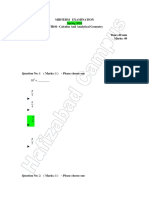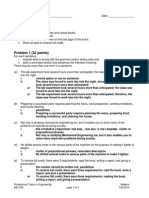MECH 234-002_ Engineering Mechanics
Uploaded by
adeyemie152MECH 234-002_ Engineering Mechanics
Uploaded by
adeyemie152New Jersey Institute of Technology
Digital Commons @ NJIT
Civil and Environmental Engineering Syllabi NJIT Syllabi
Spring 2021
MECH 234-002: Engineering Mechanics
Geraldine Milano
Follow this and additional works at: https://digitalcommons.njit.edu/ce-syllabi
Recommended Citation
Milano, Geraldine, "MECH 234-002: Engineering Mechanics" (2021). Civil and Environmental Engineering
Syllabi. 550.
https://digitalcommons.njit.edu/ce-syllabi/550
This Syllabus is brought to you for free and open access by the NJIT Syllabi at Digital Commons @ NJIT. It has
been accepted for inclusion in Civil and Environmental Engineering Syllabi by an authorized administrator of Digital
Commons @ NJIT. For more information, please contact [email protected].
MECH 234 Hybrid / Converged / Online
Spring 2021
ENGINEERING MECHANICS: STATICS
Text: 1. Beer, Johnston, Mazurek, Vector Mechanics for Engineers: Statics, 12th edition,
McGraw-Hill, 2016, ISBN 978-1-259-97726-8
2. NCEES, Fundamentals of Engineering Supplied-Reference Handbook, 8th Edition,
2nd. revision Can be purchased from bookstore or you can
reproduce pages from: http://www.ncees.org/exams/study_materials/fe_handbook/
Classes and MECH 234-002, Monday, 11:00-1:50, synchronous online / hybrid
Instructors: MECH 234-004, Wednesday, 11:00-1:50, synchronous online / hybrid
Prof. G. Milano, P.E., [email protected]
Teaching Jin Fan, PhD Candidate, [email protected]
Assistants: Tutoring via WebEx - Schedule for Tutoring will be emailed to you.
Prerequisites: Phys 111, Math 112. Provides an understanding of equilibrium of particles and
rigid bodies subject to concentrated and distributed forces.
Students must earn a C or better in this course to register for Strength of
Materials, MECH237.
“Academic Integrity is the cornerstone of higher education and is central to the ideals of this course
and the university. Cheating is strictly prohibited and devalues the degree that you are working on. As
a member of the NJIT community, it is your responsibility to protect your educational investment by
knowing and following the academic code of integrity policy that is found
at: http://www5.njit.edu/policies/sites/policies/files/academic-integrity-code.pdf.
Please note that it is my professional obligation and responsibility to report any academic misconduct to
the Dean of Students Office. Any student found in violation of the code by cheating, plagiarizing or
using any online software inappropriately will result in disciplinary action. This may include a failing
grade of F, and/or suspension or dismissal from the university. If you have any questions about the
code of Academic Integrity, please contact the Dean of Students Office at [email protected]”
Page 1 of 5
Course Policies:
Attendance is mandatory whether face-to-face or remote.
Remote learning will be synchronous via WebEx. The link is in Canvas.
Hybrid means that some learning will be from pre-recorded lectures available in Canvas.
Please turn OFF your cell phone and put it away during class time.
Pay attention during the lecture and participate with the problem solving.
Have your textbook available during class meeting or pages from the relevant chapter.
Take notes. Ask questions.
Be prepared to participate with class problem solving with your calculator. Practice.
Quizzes, Exams and Grading Policies:
There will be 3 common exams to be announced later. You will use Respondus Lockdown
Browser for these online exams and UPLOAD your worksheets to Canvas.
Common exams will be 65% of your overall grade.
There will be a Final Exam in week 15 during Finals Week. This will be 25% of your grade.
Quizzes and exams must have Free-Body-Diagrams with Force Vectors shown. ALL work must
be shown for full credit.
There will be NO make-up quizzes or exams unless there is documentation provided to the Dean
of Students Office to validate your absence. Such circumstances may include sickness
documented by a doctor or Health Service; a receipt from your mechanic for car failure; etc.
We do NOT drop the lowest grade.
We do NOT curve the grades.
GRADING GRADE RANGE GRADE
3 Common Exams …..65% 100-88 A
Homework …………..10% 87-82 B+
Final Exam ………….25% 81-76 B
75-70 C+
69-65 C
*NOTE: You cannot register for MECH 237 with a D 64-60 D*
59 and below F
Homework Policies:
Follow the syllabus and do the homework problems listed in the Syllabus
Not all assigned problems will be collected. Only a select few will be collected randomly.
NO late homework will be accepted. Homework will be uploaded to Gradescope and graded by the
Teaching Assistant. Instructions for Gradescope will be sent to you.
All homework must be submitted on quadrille 8-1/2 x 11 engineering paper sold at the NJIT
bookstore or equivalent sold at any office supply store. Write on ONLY the front of the paper.
All homework MUST include a Free-Body-Diagram to show Force Vectors. All work must be
shown for full credit. Write legibly and indicate your final answers.
Homework copied from a solution source will NOT receive any credit.
Tutoring:
Tutoring will be provided via WebEx. Additional information concerning the tutoring schedule will
be sent to you in an email. Other tutoring should be arranged with the Teaching Assistant, Jin Fan
([email protected] ) or Prof. Milano, ([email protected]).
Page 2 of 5
Problems in Blue are links to examples from a textbook by Beer & Johnston 6th edition, found at
the Reserve Desk, Library, but similar to those found in current edition with different numbers.
Week Topic Study pages Homework Problems**
Ch. 1: Introduction Sketch force polygon, use Law of
Study p. 2 - 14
1 Ch. 2: Statics of Particles, Trig Sines and Cosines to solve.
p. 16 - 25
Method (sketch force polygon) Ch. 2: 2, 5, 9, 13, 20
Ch. 2: Rectangular Components p. 29 - 35 Ch. 2: 22& 34, 23 & 32, 35
2
Equilibrium of a Particle p. 39– 46 Ch. 2: 43, 45, pulley 66
Ch. 2: Forces in Space p. 52 - 62 Ch. 2: 77 & 78, 91 & 92
3 Forces and Equilibrium in Space p. 66–70 Ch. 2: 100, 109
Review and Summary p. 75 - 78 Helpful:2-66, 89 & 90, 2-114
Ch. 3: Rigid Bodies: p. 82– 99 Ch. 3: 5, 9, 21, 24 and 29
4 Equivalent System of Forces (3.11 done on “examples.htm”)
Scalar Products (Dot Products) p. 105-113 Ch. 3: 37, 3.43 find the angle
Ch. 3: Couples and
5 p. 120 – 128 Ch. 3: 71, 73, 77, 98
Force-Couple Systems
Ch. 3: Equivalent Systems p. 136– 150
6 Ch. 3: 101, 105, 113
Review and Summary p. 161 – 168
Ch. 4: Equilibrium of Rigid Ch. 4: 3, 7, 22, 28, 33
p. 170 – 184
Bodies Ch 4: 67, 68
7 p. 195 – 198
Equilibrium of a Two-Force Body Helpful: 4.3,12, 17, 26, 30, [43,
p. 225 – 229
Review and Summary 72, 101]
Ch. 6: Analysis of Structures: p. 298 – 309 Ch. 6: 3, 7, 18, 19, 27
8
Method of Joints Helpful: 14, 27 [ 13, 28 ]
Ch. 6: Truss Analysis: p. 317 – 324 Ch. 6: 45, 47, 52, 54
9
Method of Sections
Ch. 6: Frames and Machines p. 330 – 339 Ch. 6: 76, 88, 92, 102, 105
10
Review and Summary p. 361 – 365
Ch. 5: Distributed Forces: p. 230 - 244 Ch. 5: 3, 5, 8, 9
11
Centroids and Center of Gravity Helpful: [ 25, 32, 34, 79 ]
Ch. 5: Distributed Loads p. 262– 268 Ch. 5: 66, 68, 70, 76
12
class notes Helpful: 5.78, 81, 83
Ch. 9: Distributed Forces: p. 485 – 491 Ch. 9: 4 and 8
13
Moments of Inertia p. 498 – 506 composites, Ch. 9: 32 and 34, 44
14 Ch. 9: Parallel Axis Theorem p. 513 – 519 Ch. 9: 72, 73, 74
15 Final Exam Dates to be announced by Registrar at a later date.
**Homework to be assigned by your professor. Problems will be collected randomly per
your professor. NO LATE homework can be accepted after the due date.
*Students will be informed in advance by the instructor of any modifications or deviation
from the syllabus throughout the course of the semester.
Revised by milano,10/2001, 1/2002, 1/2003, 1/2004, 9/2004, 1/2005, 8/2005, 9/2007, 8/2008, 8/2009, 1/2010, 1/2011, 8/2011, 8/2012, 1/2013, 8/2013,
7/2014, 8/2015, 1/2016, 1/2017, 7/2017, 1/2018, 8/2019, 8/2020, 1/2021
Page 3 of 5
Here is a LINK to additional solved “Recitation Examples”:
Recitation Examples
Useful solved problems from the Beer & Johnston text, an earlier edition.
Copies of the older editions are at the Reserve Desk in the Library.
Outcomes Course Matrix; MECH 234 Engineering Mechanics: Statics
Strategies, Actions ABET Student Program Assessment Methods
and Assignments Outcomes Educational
(1-7) Objectives
Student LearningOutcome 1: Provide transition from Physics (science) to Statics (engineering).
Present engineering approach and problem solving 1, 2, 4 1 Homework, exams and
techniques used for vector analysis while building on math success in future
and physics fundamentals relevant to force systems in courses.
equilibrium.
Illustrate applications to practical problems of torque, 1, 2, 4 1 Homework, bonus
moments, and couples. Reinforce the application of problems, and exams.
geometry and trigonometry to realistic-type problems and
demonstrate the application of math skills such as cross
products and dot products.
Student LearningOutcome 2: Master the concept of two-dimensional and three-dimensional vectors.
Illustrate 2D vector components and orientation using 1, 2, 4 1 Homework and exams.
trigonometry and proportions.
Use vivid Power Point examples to demonstrate analysis 1, 2, 4 1 Homework and exams.
technique for force systems on beams and trusses and
frames.
Demonstrate logical approach to spatial vectors by 1, 2, 4 1 Homework, exams, and
visualization of forces, moments. Provide basic concepts bonus challenge
for visualizing orientation of spatial components to develop problems.
techniques using geometry and projections.
Student Learning Outcome 3: Master the concept of developing free body, diagrams and how to formulate
and structure problems solving techniques which is fundamental to the solution of all engineering problems.
Demonstrate the ability to translate a problem statement 1, 2, 4 1 Homework, bonus
into a FBD and distinguish tensile and compressive challenge problems, and
members in trusses and frames while emphasizing the exams.
importance of vector directions.
.
Illustrate the approach of going from the FBD to the 1, 2, 4 1 Homework, bonus
problem solution by formulating the appropriate equation challenge problems, and
set as applied to beams, trusses, and frames. exams.
Provide numerous solved problems available on web that 1, 2, 4 1 Homework, exams and
reinforce the technique of problem solving bonus challenge
strategy.. Require numerous homework problems weekly. problems.
Rev. 1/6/13, 9/11/13
Page 4 of 5
CEE Mission, Program Educational Objectives and Student Outcomes
The mission of the Department of Civil and Environmental Engineering is:
to educate a diverse student body to be employed in the engineering profession
to encourage research and scholarship among our faculty and students
to promote service to the engineering profession and society
Our program educational objectives are reflected in the achievements of our recent alumni.
1 - Engineering Practice: Alumni will successfully engage in the practice of civil engineering within
industry, government, and private practice, working toward sustainable solutions in a wide array of
technical specialties including construction, environmental, geotechnical, structural, transportation, and
water resources.
2 - Professional Growth: Alumni will advance their skills through professional growth and development
activities such as graduate study in engineering, professional registration, and continuing education;
some graduates will transition into other professional fields such as business and law through further
education.
3 - Service: Alumni will perform service to society and the engineering profession through membership
and participation in professional societies, government, educational institutions, civic organizations, and
humanitarian endeavors.
Our student outcomes are what students are expected to know and be able to do by the time
of their graduation:
1. an ability to identify, formulate and solve complex engineering problems by applying principles of
engineering, science and mathematics
2. an ability to apply engineering design to produce solutions that meet specified needs with
consideration of public health, safety and welfare, as well as global, cultural, social, environmental
and economic factors
3. an ability to communicate effectively with a range of audiences
4. an ability to recognize ethical and professional responsibilities in engineering and make informed
judgments which must consider the impact of engineering solutions in global, economic,
environmental and societal contexts
5. an ability to function effectively on a team whose members together provide leadership, create a
collaborative and inclusive environment, establish goals, plan tasks and meet objectives
6. an ability to develop and conduct appropriate experimentation, analyze and interpret data and use
engineering judgment to draw conclusions
7. an ability to acquire and apply new knowledge as needed, using appropriate learning strategies
Rev. 4/4/12, 9/11/13, 2/13/18, 5/18/18
Page 5 of 5
You might also like
- Ebook (ISE) Engineering Mechanics Dynamics 3e Gary L. Gray, Francesco Costanzo, Robert J. Witt, Michael E. PleNo ratings yetEbook (ISE) Engineering Mechanics Dynamics 3e Gary L. Gray, Francesco Costanzo, Robert J. Witt, Michael E. Ple35 pages
- Engineering Mechanics: Statics,: Q.wang3@fdu - EduNo ratings yetEngineering Mechanics: Statics,: Q.wang3@fdu - Edu6 pages
- Engineering Mechanics-Syllabi Khalig Mammadov - Rev01No ratings yetEngineering Mechanics-Syllabi Khalig Mammadov - Rev013 pages
- MEEN 221 Section 505: Statics and Particle Dynamics: Key InfoNo ratings yetMEEN 221 Section 505: Statics and Particle Dynamics: Key Info5 pages
- Statics: ENGR 01.271 - Fall 2006 Section Place Meeting Times Instructor Office HoursNo ratings yetStatics: ENGR 01.271 - Fall 2006 Section Place Meeting Times Instructor Office Hours2 pages
- ME 1222 Applied Mechanics - Module DescriptorNo ratings yetME 1222 Applied Mechanics - Module Descriptor3 pages
- Wp-Content Blogs - Dir 13 Files 2013 01 EM-274-Syllabus-Spring-2013No ratings yetWp-Content Blogs - Dir 13 Files 2013 01 EM-274-Syllabus-Spring-20138 pages
- PHYS 102 - 008_ General Physics I LectureNo ratings yetPHYS 102 - 008_ General Physics I Lecture9 pages
- Study Guide for Pytel and Kiusalaas s Engineering Mechanics Statics Fourth Edition, Si Edition Jean Landa Pytelinstant download100% (1)Study Guide for Pytel and Kiusalaas s Engineering Mechanics Statics Fourth Edition, Si Edition Jean Landa Pytelinstant download49 pages
- PHYS 102 - 102_ General Physics I LectureNo ratings yetPHYS 102 - 102_ General Physics I Lecture9 pages
- Get (Ebook PDF) Statics and Mechanics of Materials: An Integrated Approach 2nd Edition Free All Chapters100% (5)Get (Ebook PDF) Statics and Mechanics of Materials: An Integrated Approach 2nd Edition Free All Chapters49 pages
- Semester:: Yeshiva University Yeshiva CollegeNo ratings yetSemester:: Yeshiva University Yeshiva College6 pages
- Prerequisite:: The Ability To Determine Forces and Stresses in Elementary Structural SystemsNo ratings yetPrerequisite:: The Ability To Determine Forces and Stresses in Elementary Structural Systems5 pages
- Cle201 Engineering-Mechanics TH 1.01 Ac19No ratings yetCle201 Engineering-Mechanics TH 1.01 Ac191 page
- (Ebook PDF) Statics and Mechanics of Materials: An Integrated Approach 2nd Edition 2024 Scribd Download100% (5)(Ebook PDF) Statics and Mechanics of Materials: An Integrated Approach 2nd Edition 2024 Scribd Download31 pages
- Get Business Statistics 6th Edition Levine Test Bank Free All Chapters Available100% (19)Get Business Statistics 6th Edition Levine Test Bank Free All Chapters Available66 pages
- Experiment # 2 Analysis and Design of A Low Pass Filter ObjectiveNo ratings yetExperiment # 2 Analysis and Design of A Low Pass Filter Objective7 pages
- MODULE 2 - Factoring Polynomials (Part II)No ratings yetMODULE 2 - Factoring Polynomials (Part II)12 pages
- Benchmarking The Structural Condition of Flexible Pavements With Deflection Bowl ParametersNo ratings yetBenchmarking The Structural Condition of Flexible Pavements With Deflection Bowl Parameters8 pages
- Evaluation of Output of An LTI System Using Convolution: Avishekh ShresthaNo ratings yetEvaluation of Output of An LTI System Using Convolution: Avishekh Shrestha2 pages
- GR 11 Edwardsmaths Test or Assignment Functions T2 2022 EngNo ratings yetGR 11 Edwardsmaths Test or Assignment Functions T2 2022 Eng3 pages
- Mike Hydro: Note To Existing MIKE 11 UsersNo ratings yetMike Hydro: Note To Existing MIKE 11 Users11 pages
- Learning Representations For Automatic ColorizationNo ratings yetLearning Representations For Automatic Colorization29 pages
- Chapter 4C Analysis of Structures Method of Members 2CE 3No ratings yetChapter 4C Analysis of Structures Method of Members 2CE 314 pages
- Operating Instructions - Orifice - WIKANo ratings yetOperating Instructions - Orifice - WIKA33 pages


